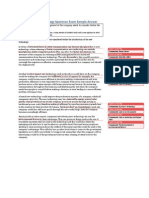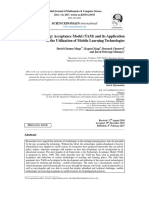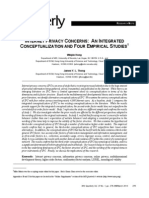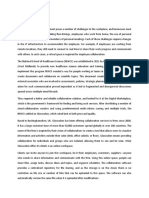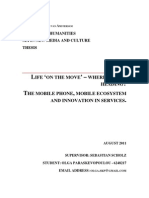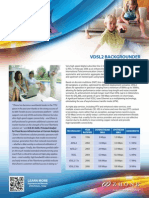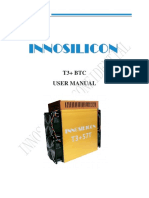Acceptance of Ubiquitous Computing
Acceptance of Ubiquitous Computing
Uploaded by
Juan MauricioCopyright:
Available Formats
Acceptance of Ubiquitous Computing
Acceptance of Ubiquitous Computing
Uploaded by
Juan MauricioOriginal Title
Copyright
Available Formats
Share this document
Did you find this document useful?
Is this content inappropriate?
Copyright:
Available Formats
Acceptance of Ubiquitous Computing
Acceptance of Ubiquitous Computing
Uploaded by
Juan MauricioCopyright:
Available Formats
UBIQUITOUS COMPUTING
ACCEPTANCE OF UBIQUITOUS COMPUTING
Monica J. Gareld
With portability similar to a spiral notebook, the tablet PC enables new ways of working. This study investigates user acceptance of this new technology through interviews with employees in four industries who participated in three-month trials.
MONICA J. GARFIELD is an assistant professor in computer information systems at Bentley College (cis.bentley.edu/mgarf ield/). Her research focuses on the use of IT to enhance creativity as well as the sociotechnical issues that impact telemedicine systems. Her work has appeared in such journals as Information System Research, MIS Quarterly, Communications of the ACM, and Journal of Management Information Systems. She is also the editor of ISWorlds database page (http://www.magal.co m/iswn/teaching/dat abase/).
N THE LAST DECADE, UBIQUITOUS computing has moved from a futuristic vision to a reality. As computing power continues to increase and hardware becomes more compact, computers have become part of our work and social life, anywhere and anytime. Beneting from the combination of wireless connectivity and portability similar to that of a traditional spiral notebook, the tablet PC is allowing people to rethink how they do their work. The tablet PC offers such features as lightweight portability, wireless connectivity, and, as the most important factor differentiating it from notebook and desktop computers, stylus input in addition to the traditional keyboard. Obviously, the purpose of these features is to allow users to perform their jobs more effectively and efciently. However, relatively little prior empirical research exists on whether users perceive that the technological benets of the tablet PC meet their business needs. Thus we are lifting the lid and looking inside the black box of tablet PC use to attempt to better understand what affects the acceptance and use of the tablet PC in the corporate world. To gain rich insights into how these computing devices are used in the corporate environment, we collected qualitative data at several corporate sites in a range of industries, including medical, education, publishing, and retail. Each organization selected a group of individuals to use the tablet PC as their primary personal computing device for three months or longer. Each study participant was trained
on how to use the device, and technical support was provided to the users throughout the study. Participants shared their experiences with us during semistructured interviews. The interviews not only gave us the opportunity to explore variables associated with technology acceptance in previous research, but also enabled new ndings to emerge. This article reports the results of this research effort.
ISSUES THAT AFFECT THE USE OF TABLET PCS
tablet PCs share many of the essential features of a nomadic information environment (Lyytinen and Yoo, 2002). They are highly mobile and benet from a large-scale infrastructure to support diverse ways in which data can be processed and transmitted. From the classroom to the racetrack, tablet PCs have been found to be highly valuable tools (Clarke, 2003; Colwell, 2004; Lowe, 2004). Yet it is unclear why they are more readily adopted in some environments yet greeted with a cautious eye in others (Clarke, 2003). To better understand the acceptance of the tablet PC in the corporate environment and its impact on users, we began by reviewing the previous work in the area of technology acceptance. Although most of the research in this area does not focus on highly mobile technologies, early lessons learned about technology acceptance ought to apply to the tablet PC. However, it should be noted that users of the tablet PC may engage in ubiquitous computing
24
W W W . I S M - J O U R N A L . C O M F A L L 2 0 0 5
UBIQUITOUS COMPUTING
TABLE 1 Unied Theory of Acceptance and Use of Technology (UTAUT)
Performance expectancy
Effort expectancy Social inuence
Facilitating conditions
The degree to which an individual believes that using the system will help him or her to attain gains in job performance (Venkatesh et al., 2003, p. 447) Includes items that relate to how useful the user perceives the technology to be, what their outcome expectations are for using the technology, and how the capabilities of the technology will help them in their job performance How easy the system is to use Includes the perceived ease of use and the experienced ease of use How important the technology user thinks other people think the use of the technology is Includes the users belief about how the technology affects their image, how much others believe they should use the technology, and how the technology ts with the social norms of the workplace The degree to which an individual believes that an organizational and technical infrastructure exists to support use of the system (Venkatesh et al., 2003, p. 453) Includes the accessibility of resources necessary to use a new technology, the support and training necessary, and the technologys compatibility with existing norms and values of the users
more often than other technology users and, thus, have a fundamental difference in the way they interface with the technology (Dey, 2001; Kim and Kim, 2003). By far, the most cited model for understanding technology acceptance is the Technology Acceptance Model (TAM), by Davis (1989) and most recently revised as the Unied Theory of Acceptance and Use of Technology (UTAUT) (Venkatesh et al., 2003). The basic concept underlying this model is that individuals will form various beliefs and attitudes regarding the technology; these will, in turn, have an impact on their intentions to use the technology and, therefore, affect their actual use of the technology. When users are presented with a new technology, numerous factors inuence their decisions about when and how they would use it. The UTAUT model can be used to understand the factors that inuence the acceptance of a specic technology, such as the tablet PC. Specically, the UTAUT model suggests that performance expectancy, effort expectancy, and social inuence affect users behavioral intentions to use the technology (i.e., how they think they will use it), and facilitating conditions will directly affect users actual behavior with the technology (see Table 1). New technologies, such as the tablet PC, create uncertainty in the minds of those who adopt them. People form attitudes and intentions toward trying to learn to use the new technology prior to initiating efforts directed at using them. Attitudes toward usage and intentions to use may be ill formed or lacking in conviction or else may occur only after preliminary attempts to learn to use the technology.
I N F O R M A T I O N S Y S T E M S F A L L 2 0 0 5
Organizations can use numerous methods to attempt to inuence employee attitudes. For example, providing users with formal training before they actually use the system to accomplish tasks would give them a chance to work with the technology before they make up their minds about how easy it is to use. Gaining experience and knowing what to expect out of the system will increase the likelihood that users will have a positive attitude toward adopting it. With this study, our intent is to help organizational decision makers understand better the factors that affect the acceptance of a ubiquitous computing technology such as the tablet PC.
FIELD STUDY METHODS
To gain rich insights into how tablet PCs are used in the corporate environment, we conducted a longitudinal, qualitative eld study based on interview data collected at each corporate site. Employees from four companies in four different vertical markets (education, medical, publishing, and retail) were given tablet PCs to use as their primary personal computing device for at least a three-month period. Participation in the study was voluntary, as was the use of the tablet PC during the study (although highly recommended). Each study participant was trained on how to use the tablet, and technical support was provided to the users throughout the study. All participants at all sites lled out a pretest questionnaire to provide a baseline on their perceptions of technology and the types of tasks they perform in the workplace. Participants also shared their experiences with us during an exit interview. This
M A N A G E M E N T
25
UBIQUITOUS COMPUTING
TABLE 2 Interview Guide
How often did you use the tablet PC? What did you think you would use the tablet PC for? What did you use the tablet PC for? Did you change the way you did things? Did the tablet PC help you to accomplish tasks more quickly? Did it improve your job performance? In the past month do you feel that you are performing your job more efciently? Did it increase your productivity? Does it seem to take less time to perform tasks now than in the recent past? Did it enhance your effectiveness on the job? Did it make it easier to do your job? Was it useful in your job? Give me an example. Did you nd the tablet PC easy to learn to operate? Did you nd it easy to get the tablet PC to do what you wanted it to do? Did you nd that your interaction with the tablet PC was clear and understandable? Did you nd the tablet PC exible to interact with? Do you feel it would be easy to become skillful in using the tablet PC? Did you nd the tablet PC easy to use?
tablet PC acceptance and those behaviors that emerged from the use of the tablet PC that appeared to impact users (see Table 2 for the initial interview questions). The interview script began with basic information about the participants use of the tablet (frequency and manner of use). These interviews followed a semistructured interview protocol, but they were also allowed to take on a reective tone. This gave us the opportunity to not only explore those paths that previous research led us to investigate but also to engage in some exploratory work to enable new ndings to emerge. As themes pertaining to the acceptance and use of the tablet PC began to emerge from the interviews, the interview questions that followed evolved and areas of interest were probed further.
TECHNOLOGY ACCEPTANCE FINDINGS
The ndings for the four technology acceptance constructs in the UTAUT model (see Table 1) are described in detail below and summarized in Table 3.
Performance Expectancy
research explored how the tablet PC is used in four environments by examining user acceptance and use of the tablet. The same researcher conducted all of the interviews. An interview script was written to guide the initial interviews. The UTAUT model guided the formation of the interview questionnaire to help us understand the more specic user behaviors that appeared to lead to
Performance expectancy relates to how well individuals believe the tablet PC helped them perform their job. We found four primary ways the tablet led to improved job performance. First, the tablet allowed for improved information exchange. Participants found that they were able to send e-mails closer to the time they received the information they needed to exchange with an individual. This increased
TABLE 3 Technology Acceptance Model Findings
UTAUT Constructs Performance expectancy
Factors Affecting tablet PC Acceptance Information exchange Multi-tasking In meetings Outside of meetings Organizing efforts Displaying and analyzing visual data Technical features Stylus Keyboard Battery life Information accessibility Perceptions of others In meetings Outside of meetings Network infrastructure Champion
W W W . I S M - J O U R N A L . C O M F A L L 2 0 0 5
Effort expectancy
Social inuence
Facilitating conditions
26
UBIQUITOUS COMPUTING
articipants in this study found the tablet was less obtrusive in meetings, and they were more willing to bring it to meetings than a laptop computer.
speed of interaction allowed for improved coordination and a reduction in information decay. For instance, some employees were able to e-mail an order when they were in their clients ofce, and participants were able to send emails to delegate projects, share information, or request information while they were still at the meeting. Second, the tablet allowed workers to multi-task. Participants in this study found the tablet was less obtrusive in meetings, and they were more willing to bring it to meetings than a laptop computer. Some participants found that they could bring just the slate portion of the tablet and use the stylus to read e-mails while participating in meetings. They felt less offensive multi-tasking in this way than with their laptops. However, it was noted by many that they would only engage in such multi-tasking when they were only peripheral to the meeting. One participant noted: I mean if youre using Journal and its laying right out there you can see that somebody is taking notes. Its no different than having a pad of paper. Thats okay. Theres no reason to ip it up and put the screen to facing me and away from you and suspicion begins. [Education sector user] Another participant said: There was no way they could have their computer up and be typing while talking to the patients because it would be very distracting to the patients. So it is basically would be the same as taking a note. [Healthcare sector user] Employees who perform much of their work away from their desk found that they could leverage their free time more productively. In the past, they needed to nd a place to set up their laptop if they wanted to use it between meetings. With the tablet they found they could more easily use it without any extra arrangements and utilize their free time between appointments due to the fact that they had their tablet with them.As one person noted: With a laptop youve got to open it up, youve got to have the space; its just not convenient. [Education sector user] Third, the tablet helped individuals with their organizing efforts. Some participants mentioned that instead of jotting new ideas on Post-it Notes, they wrote them on journal pages that they then categorized. By using the tablet
I N F O R M A T I O N S Y S T E M S F A L L 2 0 0 5
instead of pencil and paper or Post-it Notes, participants reported improvement in organization of work-related materials, which led to them being more efcient at their jobs (no more lost notes, need for multiple folders, or inaccessibility of information). For instance, one person said: Its a marvelous tool for helping me stay organized and quite honestly ending the day by ve oclock because if you dont have everything integrated in a single platform, youre wasting a lot of time. [Publishing sector user] Participants also noted that the tablet was ideal for displaying and analyzing visual data. In the healthcare organization, the participants found that the tablet was well suited for manipulating and analyzing MRI brain scans. In the past, they used regular desktop PCs, but they found the stylus and the tablet allowed them to more quickly and accurately identify the regions of the brain they wanted to look at more closely. In our work with brain imaging, we have found these tablets to be very useful, [in the past] we would do it with a mouse.The thing was it wasnt as easy. Its much more intuitive just to do it with your notepad there. The mouse on a laptop is nowhere near accurate enough to be able to make these, you know, to be able to outline these regions of interest. [Healthcare sector user] The tablet also excelled in its ability to capture categorical data.Although some found taking lengthy notes (e.g., inpatient interviews) was difcult with the tablet, they reported it was ideal for lling out forms that focused on categorical information. By using the tablet to capture such data they could then save the information into a back-end database and analyze it.
Effort Expectancy
Effort expectancy relates to how easy the participants found the tablet PC to use.The overall use of the tablet was not considered difcult. However, most individuals discussed needing to adjust to the use of the tablet. As with all technologies, there is a learning curve associated with the use of the tablet. From a technical perspective, using the stylus for handwriting recognition was a challenge. The software was
M A N A G E M E N T
27
UBIQUITOUS COMPUTING
a bit slow and cumbersome, and very few users converted their handwritten notes (via stylus entry) into text: I dont see how the stylus could help me, to tell you the truth. I spend a lot of time typing, and I can just do it so much faster. [Retail sector user] if Im going to use the Journal, my handwriting in a meeting, Im very cryptic, and its almost a waste of time to try to keep cryptic notes and try to gure out what it is I said. [Education sector user] It was extremely difcult It takes a little bit of training too on the stylus to get used to . I nally put the stylus away and went and got the keyboard. [Retail sector user] There were also mixed reviews on the keyboard. Although many participants found it hard to adjust to, those who used the keyboard frequently seemed to adjust to its size and felt comfortable with it in a relatively short period of time. A participant noted that: The keyboard itself is a little bit small and I nd that I tend to mistype sometimes more than I do with other keyboards and I sometimes hit the wrong button and I erase everything I just wrote. [Publishing sector user] Battery power was another issue raised; some participants felt that the battery life was sufcient for their work whereas others needed a longer battery life. This related to the duration of time they would be away from a location in which they could plug in: I have had issues with battery life. So if I have to nd a place to plug it in and I know where Im going, I can bring it with me, but if Im not sure, Ill typically just bring pads. [Education sector user] Other site-specic issues arose around connectivity to the network and wireless connectivity to printers. However, these issues varied based on the external communications environment of each physical location in which the tablet was used. Participants in this study also reported a high level of ease of use with respect to the ability to retrieve and consult documents that they would not have had access to prior to having the tablet. Due to lack of access to the range of information required to make decisions in our
rom a technical perspective, using the stylus for handwriting recognition was a challenge.
highly complex world, employees tended to focus on the tasks that required lower cognition when they were away from the ofce. Users reported that having the tablet available to them outside of work allowed them to conrm hunches, verify facts, and jot down insights as they occurred to them. When grappling with a perplexing issue at work, it is often during down time that one gains new insight. For instance, one participant expressed that in the past she had mostly worked on e-mails and went through snail mail over the weekend. Now that she had a tablet PC, she found that she was able to retrieve information that helped her conceptualize complex decisions she needed to consider in her job. She cited that in the past she would not bring home a laptop due to the inconvenience; now she not only brings her tablet home but she may read various documents that pertain to larger issues while at home: If I just want to sit there and study some documents, its like reading the paper. You know, Im willing to do that where I never would have e-mailed all those documents to myself and sat at the desk on a Saturday. [Education sector user] Participants noted that the accessibility of the tablet allowed them to more effectively react to the ah-ha moments that occur when one is laying in bed, taking a shower, or engaging in other domestic activities.This fundamentally alters how one uses time away from the desk and ones ability to start to leverage the ubiquitous world of anytime, anyplace computing: It makes working on airplanes more convenient because of the way the screen is set up. You can actually do it. But also, because of the stylus you can do this ne work on airplanes and at home much more easily. So it does mean that I actually do this type of data analysis on an airplane, which I never would have done before. [Healthcare sector user]
Social Inuence
Social inuence relates to how an individual perceives the use of the tablet will affect their image or please their supervisor or co-workers. Issues in this area varied by the work situation in which the tablet was used. More specically, the impact of social inuence related to whether
28
W W W . I S M - J O U R N A L . C O M F A L L 2 0 0 5
UBIQUITOUS COMPUTING
ompanies also need to assess the potential negative impact the tablet could have on the company or individual users.
the individual was using it in a group setting (i.e., a meeting) or in smaller settings. There is at least one social and behavioral obstacle to the use of the tablet PC in meetings. Many individuals felt that bringing the tablet to meetings, although improving their own personal efciency, led to potentially more costly social outcomes. There was an issue related to the perceptions others formed when one used their tablet in meetings. tablet PC users worried that other participants in the meeting would perceive they were not cognitively engaged in the meeting but were multi-tasking during the meeting when they utilized their tablet. This, in turn, can lead to the users discomfort with how others perceived them. Furthermore, there was a sense among some users that the presence of the tablet in meetings was intimidating.This came from two distinct areas. First, some people felt others would perceive the tablets presence as a way to show off in terms of either their technological savvy or their personal worth to the organization. Others felt that it may inhibit discussion for fear of the tablet recording the proceedings of the meeting and, thus, reducing the control over the information exchange within the meeting. However, in non-meeting situations users found that the tablet both enhanced their image and helped them initiate conversations. This nding was specic to the publishing industry. These participants found that the presence of the tablet led to an easy way to break the ice with new clients. They also found that it gave potential customers a better impression of the technical savvy of their organization. However, they were also concerned that these same potential customers would perceive that the cost of their product was higher than necessary due to excessive overhead spending on items such as the tablet PC: Theyre always, like, wow, what is that? It was actually questions about the computer itself. It was a good icebreaker for sales calls, especially before you know the person because theyre always kind of like impressed with it. And I was kind of wondering if any of them ever thought, you know, well that computer must be expensive and you know, theres all this talk about textbooks are expensive and why do they cost so much. [Publishing sector user] It has that implied wow, this person is a lot more techie and this company represents itself; they have a bigger
I N F O R M A T I O N S Y S T E M S F A L L 2 0 0 5
investment in technology so I should go with them. And I get a lot of adoptions I think because, they trust that, we know what were doing with technology. [Publishing sector user]
Facilitating Conditions
We provided technical support both internally and externally for all participants in this study. Whether the various organizations would provide the same level of support for the ongoing use of the tablet is unknown. It was clear that network connectivity was the primary issue organizations would need to grapple with in terms of supporting the ubiquitous use of the tablet PC. Not only was network infrastructure an issue, but the types of rewalls and security measures utilized on a network, the use of data compression, and the type of wireless connections available played a role in facilitating the use of the tablet PC. Furthermore, it became very clear that those research sites that had a strong champion for the project did better.They were more likely to invest the time to modify their work processes to leverage the features of the tablet PC and to seek out ways to improve their work performance through the utilization of the tablet. And the organizational culture was more accepting of new ways to communicate and work.
BENEFITS AND DISADVANTAGES OF THE TABLET PC
Obviously, behavioral intentions to use and actual usage will increase only if the factors uncovered in this study have been implemented so that they have a positive impact on adoption. For example, a network infrastructure with high security standards may impede the acceptance of a tablet PC because it makes it more difcult for users to achieve their goals when using the technology. Individuals and companies that value the benets provided by the tablet will accept the tablet more readily than those who do not value these benets. Companies also need to assess the potential negative impact the tablet could have on the company or individual users. For example, if a company wants to increase the speed at which it reacts to customer requests and process orders, the mobility of the tablet enables eld representatives to increase their speed of information exchange with other parts of the company, thereby having a positive impact. However, if a company is not very concerned
M A N A G E M E N T
29
UBIQUITOUS COMPUTING
TABLE 4 Benets and Disadvantages Related to Use of the tablet PC, by UTAUT Factor
Factors Related to tablet PC Acceptance Performance expectancy
Benets of the tablet PC Multi-tasking and organizing efforts leading to more effective use of time: Multi-tasking tablet PC users can use short windows of time to engage in productive work behaviors. Organization The tablet PC offers a range of features that allow one to organize various forms of information (notes, documents, e-mails, etc.) in a more effective manner. Information accessibility leading to reduced cognitive load: Necessity to recall action items eliminated. Accessibility of necessary data tablet PC users are more likely to be able to access necessary information. Action taken in closer proximity to action request. Improved image: Impression of technical savvy heightened.
Disadvantages of the tablet PC
Effort expectancy
Challenges in data input: The tablet PCs keyboard can make data entry more difcult than in other computing environments. The stylus can be difcult to use for note taking.
Social inuence
tablet can be seen as intimidating: In large meetings, participants may be unsure about the tablets function. Clients or customers may fear that they are being recorded. tablet can be seen as boasting: The tablet PC can be seen as a way for an individual to boast, due to Their technical savvy The perception that the tablet PC was given to the individual because they are special
about its speed of information exchange, tablet PC mobility would not affect its acceptance. Furthermore, if the company relies on having a buffer of a few days between an item request and the time the item is captured by a fulllment system, the use of the tablet could negatively impact the company unless other changes are also made. Table 4 summarizes the benets and disadvantages of the factors affecting tablet PC acceptance.
SUPPORTING SUCCESSFUL TABLET PC ADOPTION
successfully adopt them. First, technical issues must be addressed to fully utilize the range of capabilities that ubiquitous computing can bring: The network infrastructure needs to enable ubiquitous computing. A highly mobile stand-alone personal computing device might be useful, but the true benets of ubiquitous computing are realized only with constant availability of network resources. Security of wireless communication is an issue related to network infrastructure that requires special attention because if users dont trust the integrity and condentiality of the communication capabilities offered by a ubiquitous computing device, they will not (and should not) use them. Even worse is if
Managers can take several actions to increase the likelihood that their organization will be able to leverage the power of tablet PCs and
30
W W W . I S M - J O U R N A L . C O M F A L L 2 0 0 5
UBIQUITOUS COMPUTING
lthough the tablet does not become invisible, its nature and role as a computing device often do.
users place their trust in an untrustworthy infrastructure. Effortless printing from wireless devices was a specic issue identied by the users in this study as a critical requirement for efcient use of ubiquitous computing devices. Operational issues must also be in order: Making available (or even mandating) suitable training on the technology both prior to the introduction of the technology and later on an as-needed basis. Modifying appropriate applications so that they are suitable for tablet PC use, taking into account the special features of the tablet interface, such as the benets it provides for highly detailed visual analysis. Making more information accessible electronically so that improved access capabilities can be utilized effectively. Finally, managers need to support an organizational culture that will be able to adapt to new technical environments and provide vision and support for new technology usage, such as: Providing support for or assigning direct responsibility to a strong champion for new technologies. Fostering an innovative organizational culture that adapts to new social interfaces and work processes that are at least partially built around the use of ubiquitous computing technologies.
CONCLUSION
does not become invisible, its nature and role as a computing device often do. In addition to technical and operational issues, organizational culture will have a major impact on an organizations ability to leverage the tablet PC successfully in the work environment.
ACKNOWLEDGMENTS
I would like to thank Perry Lowe, Margi Olson, Seira Shalton, and Jim Hunton for their work on the early portions of this research effort.
References Clarke, C. (2003) Taking to the Tablets, Engineer, 292 (7637): 43. Colwell, K. (2004) Digital Ink and Notetaking, TechTrends: Linking Research & Practice to Improve Learning, 48(3): 3540. Davis, F.D. (1989). Perceived Usefulness, Perceived Ease of Use, and User Acceptance of Information Technology, MIS Quarterly, 13(3): 319339. Dey, A.K. (2001). Understanding and Using Context, Personal and Ubiquitous Computing, 5(1): 47. Kim, Hoyoun and Jinwoo Kim. (2003). PostAdoption Behavior of Mobile Internet Users: A model based comparison between continuers and discontinuers, Proceedings of the Second Annual Workshop on HCI Research in MIS. Seattle, WA, Dec 1213, 2003. Lyytinen, K. and Y.Yoo (2002). Issues and Challenges in Ubiquitous Computing, Communications of the ACM, 45(12): 6365. Lowe, P. (2004). Bentley College Students Evaluate tablet PCs. HP newsroom, feature stories, http://www.hp.com/hpinfo/newsroom/feature _stories/2004/04bentley.html?mtxs=homecorp&mtxbB1&mtxl=L1, accessed May 25, 2005. Venkatesh, V., M. Morris, G. Davis, and F. Davis (2003). User Acceptance of Information Technology: Toward a Unied View. MIS Quarterly, 27(3): 425478.
In this study, we have provided an initial understanding of how factors related to the use of the tablet PC can impact its acceptance within organizations.The mobility of this device clearly moves users closer to ubiquitous computing, because it gives them the power of the PC in a new, less intrusive form. Although the tablet
I N F O R M A T I O N
S Y S T E M S F A L L 2 0 0 5
M A N A G E M E N T
31
You might also like
- 300+ Powerful Termux Hacking Tools For HackersDocument16 pages300+ Powerful Termux Hacking Tools For HackersMohd Kamal88% (24)
- Master Thesis - FinalDocument43 pagesMaster Thesis - Finalradikas exeNo ratings yet
- The Power of Touch in Media by PHD UKDocument4 pagesThe Power of Touch in Media by PHD UKanjali_ramachan2848No ratings yet
- HW 2Document11 pagesHW 2Sander WongNo ratings yet
- Migrating To New Service ProvidersDocument20 pagesMigrating To New Service ProvidersDaniel BlanchettNo ratings yet
- 37.relationships Between IT Department Culture and Agile Software Development Practices - An Empirical InvestigationDocument12 pages37.relationships Between IT Department Culture and Agile Software Development Practices - An Empirical Investigationhuyen vuNo ratings yet
- JacquifinalcleanDocument60 pagesJacquifinalcleanapi-262210882No ratings yet
- Literature ReviewDocument7 pagesLiterature Reviewamurph16No ratings yet
- Assignment 2Document15 pagesAssignment 2api-311925791No ratings yet
- Review On Cybersickness in Applications and Visual DisplaysDocument25 pagesReview On Cybersickness in Applications and Visual DisplayszonenorNo ratings yet
- 2010 HSC Industrial Tech Speciman Exam Sample AnswerDocument2 pages2010 HSC Industrial Tech Speciman Exam Sample AnswerKelly Bauer100% (2)
- 8 Major Impacts of Information Technology On BusinessesDocument6 pages8 Major Impacts of Information Technology On BusinessesGetnet MuhabawNo ratings yet
- Factors Leading To The Acceptance of Management Information System in Public Schools: A Path AnalysisDocument11 pagesFactors Leading To The Acceptance of Management Information System in Public Schools: A Path AnalysisInternational Journal of Innovative Science and Research Technology100% (1)
- By Stutern, in Partnership WithDocument37 pagesBy Stutern, in Partnership Withdamola2realNo ratings yet
- Resource Management and Scheduling in Cloud EnvironmentDocument8 pagesResource Management and Scheduling in Cloud Environmentvickyvarath100% (1)
- TAM Davis 1989Document8 pagesTAM Davis 1989itumeleng1No ratings yet
- Advantages and Disadvantages of ComputersDocument4 pagesAdvantages and Disadvantages of Computerschris ayumaNo ratings yet
- Advantages of TechnologyDocument1 pageAdvantages of TechnologyElfren BulongNo ratings yet
- My Privacy My Decision: Control of Photo Sharing On Online Social NetworksDocument84 pagesMy Privacy My Decision: Control of Photo Sharing On Online Social NetworksGowri ShankarNo ratings yet
- Database Design - 2nd EditionDocument144 pagesDatabase Design - 2nd Editionbaiscopesubz123No ratings yet
- Effectiveness of An ICT-Skills Enhancement Short Course Program For Barangay Functionaries ICT-Based Office OperationDocument8 pagesEffectiveness of An ICT-Skills Enhancement Short Course Program For Barangay Functionaries ICT-Based Office OperationJournal of Interdisciplinary PerspectivesNo ratings yet
- How To Cite: Marikyan, D. & Papagiannidis, S. (2022) Technology Acceptance Model: ADocument12 pagesHow To Cite: Marikyan, D. & Papagiannidis, S. (2022) Technology Acceptance Model: AvineethkmenonNo ratings yet
- User Acceptance of Information Technology Toward A Unified ViewDocument71 pagesUser Acceptance of Information Technology Toward A Unified Viewhafsa el elasameNo ratings yet
- Improving Human PerformanceDocument6 pagesImproving Human PerformanceRajuNo ratings yet
- Assignment 6 Medt 7490Document2 pagesAssignment 6 Medt 7490api-555556174No ratings yet
- Social Media Pros and Cons - EditedDocument6 pagesSocial Media Pros and Cons - EditedmorrisNo ratings yet
- The Rise of Social Media and Smart DevicesDocument4 pagesThe Rise of Social Media and Smart Devicesapi-341073492100% (3)
- 2.schwaber 1995 Scrum Dev ProcessDocument23 pages2.schwaber 1995 Scrum Dev ProcessIvan WalulyaNo ratings yet
- Student Perceptions of Cloud Applications Effectiveness in Higher EducationDocument8 pagesStudent Perceptions of Cloud Applications Effectiveness in Higher EducationClaireNo ratings yet
- Internet PrivacyDocument28 pagesInternet PrivacyAngel BtNo ratings yet
- Final ProjectDocument7 pagesFinal Projectapi-510363641No ratings yet
- Exploring The Digital Health Landscape in Germany Insights From Market Dynamics Business Models and Ethical ConsiderationsDocument21 pagesExploring The Digital Health Landscape in Germany Insights From Market Dynamics Business Models and Ethical Considerationsheeducationalservices100% (1)
- Idge Cite 2014Document6 pagesIdge Cite 2014IDG_WorldNo ratings yet
- Acemoglu 2023 Can We Have Pro Worker AIDocument13 pagesAcemoglu 2023 Can We Have Pro Worker AIporota loverNo ratings yet
- Understanding The Adoption Af A Voluntary Use System From The Perspective of Health Care ProvidersDocument11 pagesUnderstanding The Adoption Af A Voluntary Use System From The Perspective of Health Care ProvidersAnisah HerdiyantiNo ratings yet
- Literature Review Human Computer InteractionDocument7 pagesLiterature Review Human Computer Interactionafmacfadbdwpmc100% (10)
- Or Case StudyDocument3 pagesOr Case StudyRonald Abletes100% (1)
- Olga Paraskevopoulou Thesis (August 2011)Document62 pagesOlga Paraskevopoulou Thesis (August 2011)Olga ParaskevopoulouNo ratings yet
- Research ProposalDocument2 pagesResearch ProposalTaylor Fullerton50% (2)
- Understanding Behavioral Intention To ParticipateDocument8 pagesUnderstanding Behavioral Intention To ParticipateLuiz Fernando Silva PintoNo ratings yet
- City University of Hong Kong: This Is A Closed-Book ExaminationDocument12 pagesCity University of Hong Kong: This Is A Closed-Book ExaminationUros CvijanovicNo ratings yet
- MG 315 Assignment 2Document4 pagesMG 315 Assignment 2Shivani PrasadNo ratings yet
- Management of Information System: Assignment No.02Document9 pagesManagement of Information System: Assignment No.02AREEBA ASIFNo ratings yet
- Facebooks Revised Policies and Terms v1.1Document61 pagesFacebooks Revised Policies and Terms v1.1nicholasdeleoncircaNo ratings yet
- Scheduling ManagementDocument95 pagesScheduling ManagementDrMohamed MustaqNo ratings yet
- Data Mining - Classification & PredictionDocument62 pagesData Mining - Classification & PredictionTrishia BabieraNo ratings yet
- An Updated and Streamlined Technology Parasuraman2014Document17 pagesAn Updated and Streamlined Technology Parasuraman2014hamdikhalis bin kadriNo ratings yet
- The Role of Marketing Capabilities For The Competitive Advantage in The Slovenian MarketDocument15 pagesThe Role of Marketing Capabilities For The Competitive Advantage in The Slovenian Marketxaxif8265No ratings yet
- Research Proposal 2 Annotated Bibliography Template 201960Document7 pagesResearch Proposal 2 Annotated Bibliography Template 201960জয়দীপ সেনNo ratings yet
- Models of E-GovernanceDocument26 pagesModels of E-GovernanceTarek HossainNo ratings yet
- Jezequel KM Technologyintegrationplaninformation 8461Document21 pagesJezequel KM Technologyintegrationplaninformation 8461api-393836486No ratings yet
- Analysis: User Profiles Personae ScenariosDocument32 pagesAnalysis: User Profiles Personae ScenariosSalmanNo ratings yet
- Procedure & Role of AccountantDocument8 pagesProcedure & Role of AccountantNur AfiqahNo ratings yet
- Niraula Nischal Research Proposal Level 6Document15 pagesNiraula Nischal Research Proposal Level 6Amit KafleNo ratings yet
- Chapter18:Technology in Workplace: Asisignments:Introduction To Business Lecture'S Name: Sem Piseth Class:Year1Document15 pagesChapter18:Technology in Workplace: Asisignments:Introduction To Business Lecture'S Name: Sem Piseth Class:Year1ហាន សេងហុងNo ratings yet
- Microsoft CorporationDocument2 pagesMicrosoft CorporationJefferson MañaleNo ratings yet
- Unit 2Document131 pagesUnit 2vineetNo ratings yet
- Alavi TP041230 UBCOM ProposalDocument2 pagesAlavi TP041230 UBCOM Proposalalavi2123No ratings yet
- The Impact of Whatsapp Messenger Usage On Students PerformanceDocument6 pagesThe Impact of Whatsapp Messenger Usage On Students PerformanceEditor IJTSRDNo ratings yet
- Reflection PieceDocument5 pagesReflection Pieceapi-316807500No ratings yet
- Product Lifecycle Management (Volume 1): 21st Century Paradigm for Product RealisationFrom EverandProduct Lifecycle Management (Volume 1): 21st Century Paradigm for Product RealisationNo ratings yet
- NE40E&80E V600R008C10 Configuration Guide - VPN 01 PDFDocument3,093 pagesNE40E&80E V600R008C10 Configuration Guide - VPN 01 PDFNisaiyhoutNo ratings yet
- C#LectureDocument2 pagesC#LectureLorence DhlakamaNo ratings yet
- Mod Menu Log - Com - Kitkagames.fallbuddiesDocument18 pagesMod Menu Log - Com - Kitkagames.fallbuddiesy7023206No ratings yet
- Vinit SINGHDocument2 pagesVinit SINGHvinitsingh1310No ratings yet
- Chapter 12Document17 pagesChapter 12Nhựt Tuấn HàNo ratings yet
- Smart Door Lock SystemDocument8 pagesSmart Door Lock SystemtmdbyatigammanaNo ratings yet
- El Microprocesador Arquitectura Risc Y Cisc: Su Juego de InstruccionesDocument34 pagesEl Microprocesador Arquitectura Risc Y Cisc: Su Juego de InstruccionesWil Bur ManNo ratings yet
- M.imam - Zuhdi.54.demonstrative Speech MatrixDocument2 pagesM.imam - Zuhdi.54.demonstrative Speech MatrixMuhammad ZuhdiNo ratings yet
- LP Hipotensi - PDFDocument20 pagesLP Hipotensi - PDFAmilah MardhatillahNo ratings yet
- Graphics LCD Interfacing With Armv7 LPC 2148: Embedded System Design Mini ProjectDocument17 pagesGraphics LCD Interfacing With Armv7 LPC 2148: Embedded System Design Mini ProjectKiran BogamNo ratings yet
- 100HSX Jul 2013Document2 pages100HSX Jul 2013roshanmechNo ratings yet
- Mediaaccess Tc4350: Ultra-Broadband Cable Modem For Gigabit SpeedsDocument2 pagesMediaaccess Tc4350: Ultra-Broadband Cable Modem For Gigabit SpeedsTom WhiteNo ratings yet
- Birst Reference Architecture For Big Data - 166509Document12 pagesBirst Reference Architecture For Big Data - 166509Mukesh PanchalNo ratings yet
- Finger Tracking in Real Time Human Computer InteractionDocument12 pagesFinger Tracking in Real Time Human Computer InteractionJishnu RemeshNo ratings yet
- FAT DocumentDocument4 pagesFAT DocumentKhaled Kamal100% (1)
- Recent Advancements in The Field of Deepfake DetectionDocument11 pagesRecent Advancements in The Field of Deepfake DetectionAnonymous Gl4IRRjzNNo ratings yet
- Ds Spirent Test Center c1 ApplianceDocument4 pagesDs Spirent Test Center c1 ApplianceTrần TiếnNo ratings yet
- Netvertex Use CasesDocument66 pagesNetvertex Use CasesAniket UmekarNo ratings yet
- Broom Broom SKRT SKRT System Analysis 2022Document3 pagesBroom Broom SKRT SKRT System Analysis 2022freddoNo ratings yet
- Lab 4 Exercise 1: Converting Feet To Meters Using Raster CalculatorDocument9 pagesLab 4 Exercise 1: Converting Feet To Meters Using Raster Calculatorumar83No ratings yet
- FPGA Design Verification FlowDocument2 pagesFPGA Design Verification FlowutkangencpsnNo ratings yet
- SoalDocument3 pagesSoalAan kurniawanNo ratings yet
- VDSL2 Primer PDFDocument4 pagesVDSL2 Primer PDFscribdart2No ratings yet
- Basic Publisher RibbonsDocument3 pagesBasic Publisher RibbonsShaneeza AnirudhNo ratings yet
- Record Book BCSL-022Document52 pagesRecord Book BCSL-022afifaNo ratings yet
- Excel Features Flyer (January 2023)Document4 pagesExcel Features Flyer (January 2023)Jose_d7No ratings yet
- Summative Exam Answer KeyDocument3 pagesSummative Exam Answer KeyMylene PastranaNo ratings yet
- T3+ BTC User ManualDocument11 pagesT3+ BTC User Manualmorteza meshkiNo ratings yet
- GHJGHJDocument1 pageGHJGHJEnzo ZulfikarNo ratings yet










